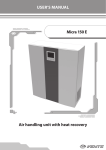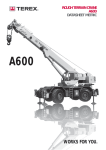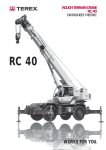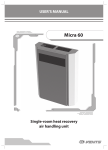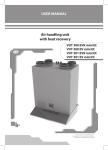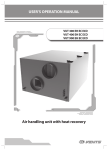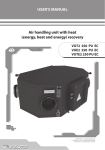Download Vents Micra 150 E User manual
Transcript
User Manual Micra 150 E Air handling unit with heat recovery Micra 150 E 2 CONTENT Introduction Use Delivery set Structural designation key Technical data Safety requirements Structure and operating logic Mounting and set-up Connection to power mains Unit control Maintenance Fault handling Storage and transportation rules Manufacturer’s warranty Acceptance certificate Electrical connection certificate Warranty card 3 3 3 3 3 4 5 6 8 8 14 15 15 15 16 16 16 3 INTRODUCTION The present user manual consisting of technical details, operating instructions and technical specification covers the installation of the MICRA 150 E air handling unit with heat recovery, VENTS series (hereinafter referred as the unit). USE The unit is designed to save thermal energy by means of heat recovery and is one of the energy saving components used in buildings and premises. The unit is designed to provide permanent controllable air exchange by mechanical ventilation in houses, offices, hotels, cafés, meeting halls and other mechanically ventilated premises as well as utilization of extract air heat energy to warm up supply purified air. The air handling unit is a component unit and is not designed for independent operation. Transported medium must not contain any flammable or explosive mixtures, evaporation of chemicals, coarse dust, soot and oil particles, sticky substances, fibrous materials, pathogens or any other harmful substances. The unit is not designed to be used by children, physically or mentally disabled persons, persons with sensory disorder or with no appropriate experience or expertise. The unit must be handled only by properly qualified personnel after the appropriate safety briefing. Install the unit to be out of reach of children. DELIVERY SET Unit - 1 item; Remote controller - 1 item; User manual - 1 item; Master plate - 1 item; Fasteners (dowel 8x80 and countersunk-headed screw) - 4 items; Shipping box - 1 item. STRUCTURAL DESIGNATION KEY MICRA 150 E Posistor electric heater Air capacity [m3/h] Unit name TECHNICAL DATA The unit is designed for operation in an enclosed area at ambient temperatures from +1 °C to + 40 °C at relative humidity of up to 80%. The unit must be grounded! Hazardous parts access and water ingress protection standard: Unit motors - IP 44; Unit assembly connected to air ducts - IP 22. The unit series designations, the main overall and connecting dimensions, outer view and technical data are given in fig. 1 and in table 1. The unit design is regularly being improved, so some models can slightly differ from those ones described in this manual. Micra 150 E 4 87 255 125 580 122,5 500 122,5 200 260 Fig. 1. Unit overall and connecting dimensions Table. 1. Technical parameters of the unit Type Микра 150 Э Unit voltage 50 Hz [V] Max. fan power [W] 1 ~ 230 9 16 Electric heater power [W] 350 Electric heater current [A] 1,6 Total unit power [W] 390 Total unit current [A] 1,68 40 Max. air capacity [m3/h] 60 105 150 Rotation speed [min ] 450 780 2000 Уровень звукового давления на расст. 3м, dB(A) 30 35 38 -1 Max. transporting air temperature [°C] from -25 up to +50 Casing material polymer coated steel Insulation 10 mm foam rubber Heat recovery efficiency, % 60 - 80 Heat exchanger type counter-flow Heat exchanger material polystyrene Supply Filter: Extract G4 G4 Connected duct diameter [mm] Ø 125 Weight [kg] 20 SAFETY REQUIREMENTS While operating and mounting the unit consider the requirements of the present operation manual as well as general requirements of all applicable local and national building and electrical codes and standards. The unit must be grounded! Before connecting the unit to power mains make sure that the unit is free of any visible damages or any other foreign objects inside the casing that can damage the impeller blades. Warning! Disconnect the unit from power supply prior to any mounting, servicing, connection or repair operations with the unit. 5 Restrictions! • Do not operate the unit beyond the specified temperature range or in an aggressive and explosive medium! • Do not connect clothes dryers or similar equipment to the ventilation system! • Do not operate the unit in the air and dust mixture medium! STRUCTURE AND OPERATING LOGIC The unit operating principle is as follows (fig. 2). Warm stale air from the premises extracted by the unit is purified in the extract filter, then it passes through the heat exchanger and then is exhausted outside through the ducts by the exhaust fan. Clean cold intake air supplied to the unit is purified in the supply filter. The air passes through the heat exchanger and then fed into the premises by the supply fan. Thermal energy of warm extract air is transferred to clean intake fresh air from outside and warms it up. The air flows are fully separated. Heat recovery minimizes thermal energy losses, energy demand and operating costs for heating during winter time. The unit is equipped with a posistor 350 W electric heater to enable supply air warming up. The heater has overheating protection. Intake air Exhaust air SUPPLY FILTER EXTRACT FAN HEAT EXCHANGER Extract air DRAIN PAN Supply air POSISTOR ELECTRIC HEATER SUPPLY FAN EXTRACT FILTER Fig. 2. Design and operating logic Micra 150 E 6 MOUNTING AND SET-UP Mount the unit to provide enough access for maintenance or repair operations. The wall for mounting must have even surface. Any surface irregularities will lead to unit casing skew and may prevent the unit from operating properly. The minimum distances from the unit to the mounting surfaces are shown in fig. 3. min 300 mm min 300 mm Fig. 3. Minimum distance from the unit to the surfaces The unit is designed for installation directly in the premise to be ventilated. Prior to starting mounting operations mark and bore holes in the wall with the master plate, fig. 4. Mounting sequence with the master plate, fig. 5: 1. Fix the master plate on the wall with a self-adhesive tape at required level. 2. Indicate two marks for two holes Ø130 mm for air ducts and four holes Ø 8 mm for the unit fasteners. 3. Take off the master plate and drill through holes for the air ducts and holes, 90 mm deep for the unit fasteners. Insert the dowels, remove the perforated fillers for the air ducts from the master plate and re-install the master plate back using a self-adhesive tape. 4. Insert the air ducts into the respective openings in the master plate. 5. Fill the spaces between the air ducts and the wall with a mounting foam through the specially designed holes in the master plate. Wait till a mounting foam hardens (solidification time depends on the foam mark), take off the master plate and remove the foam excess. Cut off the protruding air duct parts to be flush with the wall surface. 6. Insert the unit spigots to the air ducts. 7. Open the access door in the unit and remove the heat exchanger. 8. Mount the unit to the wall with the countersunk head screws and 8x80 dowels (included into delivery set) into two Ø 8 mm holes. 9. Install the heat exchanger and close the access door. 10. Fix the outer ventilation box (not included into delivery set) or Ø 125 mm ventilation grille on the outer wall of the building. 85 497 420 255 Point for cable rounding inside the unit. 2 holes for Ø 125 mm air duct. Fill the gaps between the wall and the air ducts with a mounting foam. Point for cable rounding inside the unit. 38,5 Drill 4 holes with Ø 8 tool for 90 mm deep as per master plate. Fig. 4 Master plate Drill 4 holes with Ø 8 tool for 90 mm deep as per master plate. 145 190 180 545 575 2 holes for Ø 125 mm air duct. Fill the gaps between the wall and the air ducts with a mounting foam. 7 1. 2. 3. 4. 5. 6. 7. 8. 9. Fig. 5. Unit mounting with the master plate TWO Ø 125 MM AIR DUCTS FOUR DOWELS WITH A SCREW UNIT Fig. 6. Unit mounting FOUR DOWELS WITH A SCREW (INCLUDED INTO OUTER BOX DELIVERY SET) OUTER BOX Micra 150 E 8 CONNECTION TO POWER MAINS Disconnect the unit from the power mains prior to any operations. The unit must be plugged into a properly installed power socket with an earthed terminal. The rated electrical parameters of the unit are shown on the rating plate. Any tampering with the internal connections is prohibited and will void the warranty. The unit is designed for connection to 230 V / 50 Hz single-phase AC mains. The unit is supplied with a power cable and a plug. The unit must be connected to power mains through a grounded power socket compliant with IEC 60884-1. The power cable is pre-wired to the terminal block X1 by the manufacturer, fig. 7. Connect the unit to power mains through the external automatic circuit breaker integrated into the fixed wiring system. Install the circuit breaker to have a free quick access in case of need to turn the unit off promptly. The circuit breaker trip current must be in compliance with the current consumption. The recommended circuit breaker rated current is 2.5 A. While selecting the automatic circuit breaker consider the maximum wire temperature that depends on the wire type, insulation, length and layout way (open wire mounting, channel type or wall-mounted). UNIT X1 XP3 L N 1 2 L 3 PE LA 4 5 N 6 PE ~ 230 V / 50 Hz Fig. 7. Power cable connection to terminal block UNIT CONTROL Control panel Remote controller Unit on/off Fan speed up Heater off Heater on Fan speed down Medium speed on Low speed on High speed on Scheduled operation on Timer on/off Remote Controller Fan speed control buttons Unit on/off Mode control buttons (see description below) Fig. 8. Control panel and remote controller 9 The unit is controlled from the control panel as well as from the remote controller, fig. 8. 1. Turning unit ON/OFF To turn the unit ON/OFF: from the control panel: press the button Turning unit ON/OFF ; from the remote controller: press the button Turning unit ON/OFF . The display shows the following indications as the unit is turned off, fig. 9: Indoor temperature; Weekday; Time; OFF indication ; When air supply to the heating elements is activated, the and indicator glows. Synchronously, countdown of the air supply to the heater time starts (min : s). Fig. 9. Display of the turned off unit The panel shows the following indications as the unit is turned on, fig. 10: Indoor temperature; Weekday; Time; Fan speed indicator Timer status information; • The indicator is turned on. • The indicator timer is turned off. ; is displayed as the timer is displayed as the Heater status. If the heater is turned on, the indicator displayed. is Fig. 10. Display in turned ON 2. Unit ventilation mode control. The unit fan speed is controlled: From the control panel: press the button speed - high speed); for setting speed up or the button From the remote controller: press the button medium speed - high speed); From the remote controller: press the button for setting speed down (low speed - medium for setting speed up or the button to activate low speed, the button for setting speed down (low speed to activate medium speed and the button to activate high speed. The control panel displays the current fan speed: Indicator — low speed mode; Indicator — medium speed mode; Indicator — high speed mode. 3. Supply air warming up. The electric posistor heater warms up supply air during cold season. To turn the heater ON/OFF: From the control panel: press and hold the button From the remote controller: press the button and then press the button . to turn the heater on, press the button to turn the heater off. Micra 150 E 10 Warning! If the heater is on, the unit can be turned off only after 20 seconds after turn-off command to ensure the heater cooling. In this case the indicator is displayed. 4.Timer. The timer is designed to switch the fans to maximum speed with subsequent automatic reset to a previous speed after set time period, from 20 to 60 minutes. To turn the timer on/off: from the control panel: press and hold the button and then press the button . Press the button once to set the timer for 20 minutes, each subsequent pressing extends the timer setting for 10 minutes. The maximum timer setting is 60 minutes. Press and hold the for 3 seconds to turn the timer off; button from the remote controller: press the button to turn the timer for 20 minutes on. To turn the timer off press the button . or 5. Heat exchanger freezing protection. If exhaust air temperature downstream of the heat exchanger is below +3 °C , the supply fan is turned off. After supply air temperature rises above +3 °C, the unit reverts to the set operating mode. 6. Unit setup modes. RE-ADJUSTMENT OF THE UNIT SETTINGS RESULTS IN LOSS OF THE FACTORY SETTINGS! FAN SPEED AND TEMPERATURE SENSOR SETUP IS POSSIBLE ONLY FROM THE WALL-MOUNTED CONTROL PANEL! Fan capacity setup mode. The capacity of low, medium and high speeds are adjustable. To enter the fan speed setup mode, turn the unit off. Then press and hold the button on the control panel and hold the button pressed for 3 seconds. Access to the setup mode is confirmed by the indicator and fig. 11 on the control panel display. To select the required speed to be adjusted use the buttons and . During fan speed setup the selected speed is displayed by the indications , or . Fig. 11. Fan speed setup To adjust the supply fan capacity press and hold the button to set the fan speed down. Each pressing of the button button and then press the button and to set the fan speed up or the increases or decreases the supply fan by 1%. If the button remains pressed the display indicators show the current supply fan speed, fig. 12. To adjust the supply fan speed press and hold the button the button button for setting speed down. Each pressing of the button and regulate the speed by the button and for setting speed up and increases or decreases the exhaust fan speed by 1%. If the remains pressed the display indicators show the current exhaust fan speed. To exit the fan speed setup mode and save changes . press the button Fan speed adjustment is not possible with the remote controller. 11 To reset the unit to the factory settings, enter the fan speed setup mode, synchronously press and hold the buttons and for 3 seconds. Factory fan speed settings: low speed — 40 % medium speed — 70 % high speed — 100 % Fig. 12. Fan speed setup 7. Filter replacement signal. As the filter service life expires (3000 hours) the control panel displays a filter replacement indicator temperature, fig. 13. , instead of the operating In case of the filter replacement signal turn the unit and disconnect it from power mains. Then off with the button replace the filters following the filter replacement procedure in the section «Technical maintenance», page 14. After that press the button the button on the control panel or on the remote controller to turn the unit on. Then press synchronously the buttons motor meter. and to reset the Fig. 13. Filter replacement signal 8. Date and time setup. Turn the unit off. Press and hold the button , then press the button on the control panel to enter the date and time setup mode. Keep the button , pressed and select a parameter to be edited using the buttons The date and time setup parameters are located as listed: 1. Minutes; 2. Hours; 3. Weekday; 4. Date; 5. Month; 6. Year. Then set the required parameter with the buttons Press the button . An editable parameter blinks. on the control panel. to exit the date and time setup mode.. 9. Time scheduled operation. Press and hold the button indicator and and , then press the button on the control panel to activate the time-scheduled operation. The confirms that the unit time-scheduled operation is activated. Press and hold the button , and then press the button on the control panel to deactivate the time-scheduled operation. Press the button on the remote controller to activate or deactivate the unit time-scheduled operation. The timer control has higher priority with respect to the time-scheduled operation. Micra 150 E 12 10. Time-scheduled operation setup. Each weekday has four entries that determine the fan switching to the set fan speed, turning the heater on or off. button To enter the time-scheduled operation setup mode, turn the unit off with the button on the control panel or with the on the remote controller. Press and hold the button on the control panel and the press the button . Weekday Entry number Heater status Time — Heater OFF — Heater ON Fans speed Fig. 14. time-scheduled operation indicators Hold the button and select a required parameter to be adjusted using the buttons Set a required parameter using the same buttons Time-scheduled operation parameters, fig. 14: • Entry number - each weekday has four entries. • Weekday - setup of a weekday. • • • and and . . Heater status - setup of the heater status for the current entry. Fan speed - setup of the fan speed for the current entry. Time - time setup for the current entry. - heater on, To copy the set entries for the next day press and hold the button Monday is possible. - heater off. and press the button . No copying from Sunday to Press the button on the control panel or the button on the remote controller to exit the time-scheduled operation setup mode. A programming example for setup of the time-scheduled operation is stated in the table 2. The time-scheduled operation mode is adjusted for warm season by default. While adjusting the time-scheduled operation mode set the heater status Table 2. Programming example Entry number Weekday 1 Start time Mo. 07:00 Tu. 07:00 We. 07:00 Th. 07:00 Fr. 07:00 Sa. 10:00 Su. 10:00 Mode medium speed medium speed medium speed medium speed medium speed medium speed medium speed 2 Heater status Start time Off. 08:00 Off. 08:00 Off. 08:00 Off. 08:00 Off. 08:00 Off. 12:00 Off. 12:00 Mode low speed low speed low speed low speed low speed medium speed medium speed 3 Heater status Start time Off. 17:00 Off. 17:00 Off. 17:00 Off. 17:00 Off. 17:00 Off. 17:00 Off. 17:00 Mode medium speed medium speed medium speed medium speed medium speed medium speed medium speed 4 Heater status Start time Off. 22:00 Off. 22:00 Off. 22:00 Off. 22:00 Off. 22:00 Off. 23:00 Off. 23:00 Mode low speed low speed low speed low speed low speed low speed low speed Heater status Off. Off. Off. Off. Off. Off. Off. . 13 3. 11. Alarms. In case of alarm the unit is turned off and the control panel display the alarm indicators, fig. 15. The possible alarms are listed in the table Temperature sensor alarm Condensate drain pan is full Freeze protection sensor breakout Fig. 15. Alarm indication Table 3. Unit alarms ALARM Temperature sensor alarm INDICATION FAULT HANDLING Contact your Seller for servicing. Duct temperature sensor breakout Contact your Seller to remove the freeze protection temperature sensor. Freeze protection sensor breakout Follow the drain pan servicing sequence, "Maintenance section", page 14. Micra 150 E 14 MAINTENANCE The unit requires maintenance works 3-4 times per year. Maintenance includes regular cleaning and the following operations: 1. Filter maintenance (3-4 timed per year). Dirty filters increase air resistance in the system and reduce supply air volume. The filters require cleaning as they get clogged, but at least once in 3-4 months. Vacuum cleaning is allowed. Replace the filters as they get clogged following the second cleaning. Contact your seller for new filters. To remove the filters, follow the procedure in the fig. 16: 1. Open the unit access door. 2. Remove the supply air filter above the heat exchanger; 3. Remove the heat exchanger from the unit by pulling its band; 4. Press the clamp and remove it; 5. Remove the extract air filter. Install the filter in the reverse order. 1. 2. 4. 3. 5. Fig. 16. Filter maintenance 2. Heat exchanger inspection (once per year). Some dust can get accumulated on the heat exchanger block even in case of regular maintenance of the filters. To maintain the high heat exchange efficiency, regular cleaning is required. To clean the heat exchanger pull it out of the unit and flush it with warm soap or mild detergent water solution. Re-install the dry heat exchanger to the unit. 3. Fan inspection (once per year). Even in case of regular filter and heat exchanger maintenance, some dust and grease can get accumulated inside the fans and reduce the fan performance and supply air flow. Clean the fans with a soft cloth or brush. No water and abrasive detergent, sharp objects or solvents are allowed for cleaning to prevent the impeller damage. 4. Condensate removal (as required). The drain pipes may get filled with condensate during cold season. As the drain pan gets filled with condensate, the unit is turned on and the control panel displays the indicator ( ) to remind about the need to remove the condensate. To remove condensate: 1. Disconnect the unit from power mains. 2. Open the unit door. 3. Lift the condensate level switch. 4. Keep the condensate level switch, pull and remove the condensate drain pan carefully. 5. Empty the drain pan, lift the condensate level switch and re-install it back. 5. Supply air flow control (twice per year). Leaves and other pollutions can clog the supply air grille and reduce the unit performance and supply air volume. Check the supply grille twice per year and clean it as required. 6. Ductworks inspection (once in 5 years). Even if you follow all the listed maintenance guidelines, some dust can get accumulated inside the air ducts and reduce the unit performance. Duct maintenance means their regular cleaning or replacements. 15 FAULT HANDLING Possible faults and fault handling Problem Possible reasons The fans do not get started No power supply. Cold supply air. Low set air flow. Noise, vibration Water leakage. Fault handling Make sure the power supply line is connected correctly, otherwise troubleshoot the connection error. The extract filter is soiled. Clean or replace the extract filter. The heat exchanger is frozen. Check the heat exchanger for icing. Shut the unit off if required and turn it on after the freezing danger is no longer imminent. The heater malfunction. Please contact your Seller for servicing. The filters, the fans are soiled, the heat exchanger is soiled. Clean or replace the filters; clean the fans and the heat exchanger. Check opening of the diffusers and louvre shutters, check the extract hood and supply grille and clean it of required; make sure the air ducts are not soiled and not damaged. Clean the fan impeller. Tighten the screws to stop. The ventilation system is soiled or damaged. The impeller is clogged. Loose screw tightening. The condensate level switch malfunction. Please contact your Seller for servicing. STORAGE AND TRANSPORTATION RULES Store the unit in the manufacturer’s original packing box in a closed ventilated premise with temperature range from +10°C to +40°C and relative humidity less than 80% (at +20°C). Vapours or particles which can cause corrosion or damage the insulation or connection tightness are not allowed in the storage environment. Use hoist machinery for handling and transportation to prevent possible mechanical damages of the unit. Fulfil the requirements for transportation of the specified cargo type during cargo-handling operations. Use any vehicle types for the unit transportation provided that it is protected against mechanical or weather damage. Avoid any mechanical shocks and strokes during handling operations. MANUFACTURER’S WARRANTY Manufacturer hereby guarantees normal performance of the unit during two years from the date of retail sale provided compliance with transport, storage, mounting and operation regulations. In case of no confirmation of the sales date the warranty period is calculated from the manufacturing date. In case of failures in the unit operation during the warranty period the manufacturer will accept reclamations and complaints from the owner of the device only after receiving technically sound act with detailed description of the failure. Unit damage as a result of unauthorized tampering with the circuit diagram is not a warranty case. For warranty and post-warranty services of the unit please contact the product manufacturer. In case of warranty claim please submit the present user’s manual with the seller’s stamp, filled connection certificate and warranty card. Warranty repair services and post-warranty services are fulfilled at the manufacturing facility. WARRANTY CLAIMS ARE ACCEPTED WITH THIS USER’S MANUAL AND FILLED CONNECTION CERTIFICATE ONLY. The MANUFACTURER is not responsible for any mechanical or physical damages resulting from the manual requirements violence, the unit misuse or gross mechanical effect. Fulfil the requirements set in the user’s manual to ensure proper functioning of the unit. Micra 150 E 16 ACCEPTANCE CERTIFICATE The air handling unit with heat recovery Micra 150 E has been duly certified as serviceable. We hereby declare that the product complies with the essential protection requirements of Electromagnetic Council Directive 2004/108/ EC, 89/336/EEC and Low Voltage Directive 2006/95/EC, 73/23/EEC and CE-marking Directive 93/68/EEC on the approximation of the laws of the Member States relating to electromagnetic compatibility. This certificate is issued following test carried out on samples of the product referred to above. Acceptance Inspector’s Stamp Date of manufacture ______________________________________ Sold by Seller’s name and stamp ___________________________________________________________________________________________ ________________________________________________________________________________________________________________ ________________________________________________________________________________________________________________ Date of sale _____________________________ ELECTRICAL CONNECTION CERTIFICATE This is to certify that the air handling unit with heat recovery Micra 150 E has been connected to power mains pursuant to the requirements stated in the present user’s manual by a qualified technician: Company:_______________________________________________________________________________________________________ Name __________________________________________________________________________________________________________ Date____________________________________Signature________________________________________________________________ ________________________________________________________________________________________________________________ ________________________________________________________________________________________________________________ ________________________________________________________________________________________________________________ WARRANTY CARD ______________________________________________________________________________________________________ ______________________________________________________________________________________________________ ______________________________________________________________________________________________________ ______________________________________________________________________________________________________ ______________________________________________________________________________________________________ ______________________________________________________________________________________________________ ______________________________________________________________________________________________________ ______________________________________________________________________________________________________ _________________________________________________________________________________________________ 2013 V73-1EN-04

















